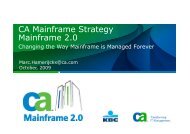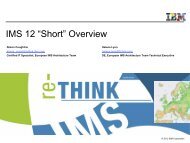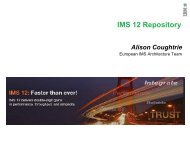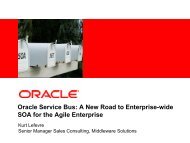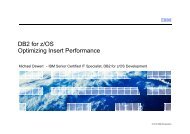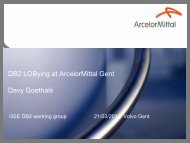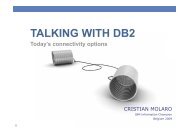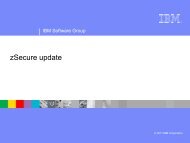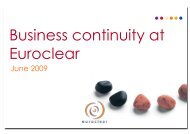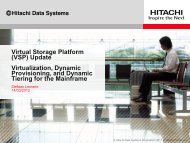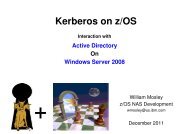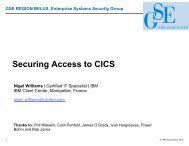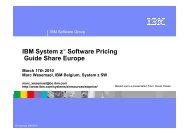DB2 for z/OS & zIIP and zAAP - GSE Belux
DB2 for z/OS & zIIP and zAAP - GSE Belux
DB2 for z/OS & zIIP and zAAP - GSE Belux
Create successful ePaper yourself
Turn your PDF publications into a flip-book with our unique Google optimized e-Paper software.
<strong>DB2</strong> <strong>for</strong> z/<strong>OS</strong> <strong>and</strong> <strong>zIIP</strong> & <strong>zAAP</strong><br />
Timm Zimmermann & Adrian Burke<br />
IBM <strong>DB2</strong> <strong>for</strong> z/<strong>OS</strong> Development<br />
tizimm@de.ibm.com<br />
aburke@us.ibm.com<br />
© 2012 IBM Corporation
Important Disclaimers<br />
Disclaimer:<br />
In<strong>for</strong>mation regarding potential future products is intended to outline our general<br />
product direction <strong>and</strong> it should not be relied on in making a purchasing decision.<br />
The In<strong>for</strong>mation mentioned regarding potential future products is not a<br />
commitment, promise, or legal obligation to deliver any material, code or<br />
functionality. In<strong>for</strong>mation about potential future products may not be<br />
incorporated into any contract. The development, release, <strong>and</strong> timing of any<br />
future features or functionality described <strong>for</strong> our products remains at our sole<br />
discretion.<br />
Per<strong>for</strong>mance Disclaimer:<br />
This document contains per<strong>for</strong>mance in<strong>for</strong>mation based on measurements done<br />
in a controlled environment. The actual throughput or per<strong>for</strong>mance that any user<br />
will experience will vary depending upon considerations such as the amount of<br />
multiprogramming in the user’s job stream, the I/O configuration, the storage<br />
configuration, <strong>and</strong> the workload processed. There<strong>for</strong>e, no assurance can be<br />
given that an individual user will achieve throughput or per<strong>for</strong>mance<br />
improvements equivalent to the numbers stated here.<br />
1<br />
© 2012 IBM Corporation
Agenda<br />
• Specialty Engines<br />
• How can SE help me<br />
• What is eligible as of V10?<br />
• Where do I look?<br />
– Customer example<br />
• What can I control?<br />
– Parallelism<br />
• Recent enhancements<br />
CP<br />
DRDA<br />
DRDA<br />
<strong>DB2</strong>/Util<br />
<strong>DB2</strong>/ Util<br />
Warehouse<br />
High<br />
utilization<br />
Reduced<br />
utilization<br />
CP<br />
DRDA<br />
warehouse<br />
<strong>DB2</strong>/ Util<br />
<strong>zIIP</strong><br />
DRDA<br />
Warehouse<br />
<strong>DB2</strong>/ Util<br />
2<br />
© 2012 IBM Corporation
Mainframe Innovation: Specialty Engines<br />
Internal Coupling<br />
Facility (ICF) 1997<br />
Integrated Facility <strong>for</strong><br />
Linux ® (IFL) 2000<br />
System z Application Assist<br />
Processor (<strong>zAAP</strong>) 2004<br />
Eligible <strong>for</strong> <strong>zAAP</strong>:<br />
! Java execution<br />
environment<br />
! z/<strong>OS</strong> XML System<br />
Services<br />
IBM System z Integrated<br />
In<strong>for</strong>mation Processor<br />
(<strong>zIIP</strong>) 2006<br />
Eligible <strong>for</strong> <strong>zIIP</strong>:<br />
• <strong>DB2</strong> remote access ,<br />
BI/DW,Utilities Build Index <strong>and</strong><br />
Sort processing, XML Parsing,<br />
RUNSTATS, BP Prefetch,<br />
Deferred Write<br />
• z/<strong>OS</strong> XML System Services<br />
• HiperSockets <strong>for</strong> large<br />
messages<br />
• IPSec encryption<br />
• z/<strong>OS</strong> Global Mirror (XRC)<br />
• IBM GBS Scalable Architecture<br />
<strong>for</strong> Financial Reporting<br />
• z/<strong>OS</strong> CIM Server<br />
• ISVs<br />
3<br />
© 2012 IBM Corporation
Specialty Engines<br />
ICF<br />
z/<strong>OS</strong> LPAR<br />
WAS<br />
Application<br />
<strong>zAAP</strong><br />
Application<br />
not on System z<br />
Linux on System<br />
z LPAR<br />
Application<br />
TCP/IP<br />
HiperSockets<br />
TCP/IP<br />
IFL<br />
D<br />
R<br />
D<br />
A<br />
DRDA<br />
<strong>DB2</strong><br />
WAS<br />
DRDA<br />
<strong>zIIP</strong><br />
Application<br />
z/<strong>OS</strong> LPAR<br />
T4<br />
<strong>zAAP</strong><br />
T2<br />
Application<br />
CP<br />
The IBM System z<br />
specialty engines<br />
can operate on the<br />
same machine<br />
together<br />
TCP/IP<br />
HiperSockets<br />
4<br />
© 2012 IBM Corporation
How can specialty engines help me?<br />
• Hardware costs: move work from GP to <strong>zIIP</strong> (<strong>zAAP</strong>), higher cost to lower cost<br />
processors, possibly postpone an upgrade<br />
– Specialty engines run at full rated speed of processor, so it could be the fastest one<br />
on the CEC<br />
• Software costs: MSU units, generally increases with the # of general processors<br />
• BUT/AND…. it can also result in latent dem<strong>and</strong> processing so processor<br />
utilization remains constant<br />
5<br />
© 2012 IBM Corporation
Work is dispatched<br />
• St<strong>and</strong>ard dispatchable units (DUs) are the Task Control Block <strong>and</strong> the Service<br />
Request Block<br />
– TCB runs at dispatching priority of address space <strong>and</strong> is pre-emptible<br />
– SRB runs at supervisory priority an is non-pre-emptible<br />
• Advanced dispatching units<br />
– Enclave<br />
• Anchor <strong>for</strong> an address space-independent transaction managed by WLM<br />
• Can comprise multiple DUs (TCBs <strong>and</strong> Enclave SRBs) executing across multiple address<br />
spaces<br />
– Client SRB<br />
• Created <strong>and</strong> executed like <strong>and</strong> ordinary SRB but runs with (Scheduler) dispatching priority<br />
<strong>and</strong> is pre-emptible<br />
– Enclave SRB<br />
• Created <strong>and</strong> executed like an ordinary SRB but runs with Enclave dispatching priority <strong>and</strong> is<br />
pre-emptible<br />
6<br />
© 2012 IBM Corporation
Work is dispatched<br />
• z/<strong>OS</strong> dispatches <strong>DB2</strong> work in either TCB, Client SRB, or Enclave SRB mode if<br />
request is local or an Enclave SRB (Service Request Block) mode if request is<br />
distributed. Under these modes of operation the parallel tasks are assigned the<br />
same importance as the originating address space.<br />
• Pre-emptible enclaves are used to do the work on behalf of the originating<br />
address space. Enclaves are grouped by common characteristics into service<br />
classes <strong>and</strong> since they are pre-emptible, the z/<strong>OS</strong> dispatcher can interrupt these<br />
tasks <strong>for</strong> more important ones There are two types of pre-emptible SRBs: client<br />
SRBs <strong>and</strong> enclave SRBs.<br />
• If the <strong>DB2</strong> <strong>for</strong> z/<strong>OS</strong> request is coming in over distributed (ie DRDA over TCP/IP)<br />
then that work is executed in enclave SRBs.<br />
– only the enclave SRB work is eligible to be redirected to the <strong>zIIP</strong>.<br />
7<br />
© 2012 IBM Corporation
TCB <strong>and</strong> SRB Times – Major Contributors in <strong>DB2</strong><br />
Application DBAS SSAS IRLM<br />
ACCOUNTING<br />
STATISTICS<br />
T<br />
C<br />
B<br />
SQL processing<br />
Lock requests<br />
Buffer updates<br />
Global lock requests*<br />
Synch I/O<br />
Logical logging<br />
GBP reads*<br />
Dataset Open/Close<br />
DBM1 Full<br />
System Contraction<br />
Pre<strong>for</strong>mat<br />
Extend<br />
Archiving<br />
BSDS processing<br />
Error checking<br />
Management<br />
S<br />
R<br />
B<br />
The same as in TCB case, but<br />
only in enclave pre-emptible<br />
SRB mode.<br />
Reported in TCB<br />
instrumentation.<br />
Deferred write<br />
Castout*<br />
Notify Exit*<br />
Prefetch read<br />
Parallel child tasks<br />
Async GBP write*<br />
P-lock negotiation*<br />
Delete Name*<br />
GBP checkpoints*<br />
Physical log write<br />
Thread deallocation<br />
Update commit<br />
incl. page P-lock unlock*<br />
Backouts<br />
Checkpoints<br />
Local IRLM latch<br />
contention<br />
IRLM <strong>and</strong> XES<br />
global contention*<br />
Async XES request*<br />
P-lock negotiation*<br />
Deadlock detection<br />
Delete Name = pageset close or pseudo-close to convert to non-GBP dependent<br />
(*) Data Sharing specific<br />
Eligible to run on <strong>zIIP</strong><br />
8"<br />
© 2012 IBM Corporation
What is DRDA ?<br />
• DRDA = Distributed Relational Database Architecture<br />
– Developed by IBM<br />
– Enables relational data to be distributed among multiple plat<strong>for</strong>ms – any app to any<br />
db <strong>and</strong> any db to any db.<br />
– Applications <strong>and</strong> APIs accomplish the actual implementation<br />
• DRDA is native to <strong>DB2</strong> <strong>for</strong> z/<strong>OS</strong>. It reduces the need <strong>for</strong> additional gateway products that<br />
may affect per<strong>for</strong>mance <strong>and</strong> availability<br />
• The Open Group adopted DRDA in 1998 as the open st<strong>and</strong>ard <strong>for</strong> database access<br />
interoperability (<strong>DB2</strong>, In<strong>for</strong>mix, Oracle)<br />
• Private Protocol, also IBM, was stabilized in V4 of <strong>DB2</strong><br />
• DRDA can use TCP/IP or SNA as a network protocol to flow comm<strong>and</strong>s<br />
How does that affect the <strong>zIIP</strong>:<br />
if <strong>DB2</strong> <strong>for</strong> z/<strong>OS</strong> workload comes over TCP/IP <strong>and</strong> is DRDA compliant,<br />
a portion of that <strong>DB2</strong> workload is eligible to be redirected to the <strong>zIIP</strong>.<br />
As of V9 SNA protocol incurs an overhead due to double buffering (private shared)<br />
" Private Protocol support is removed in V10<br />
App<br />
or<br />
DB<br />
9<br />
© 2012 IBM Corporation
How many <strong>zIIP</strong>s should I have?<br />
• zCP3000 study<br />
– Provided by IBM Techline<br />
• Send in SMF 30s, 70s<br />
– Breakdown of eligible work<br />
– Overlay 4 hour peak<br />
– See collisions of workloads<br />
– Remember to normalize<br />
http://www-03.ibm.com/support/<br />
techdocs/atsmastr.nsf/WebIndex/<br />
PRS3948<br />
10<br />
© 2012 IBM Corporation
<strong>zIIP</strong> usage<br />
• How many <strong>zIIP</strong>s do you need (this scenario 12:1 ratio CP to <strong>zIIP</strong>)<br />
– <strong>zIIP</strong> eligible work that went to CP either <strong>zIIP</strong> is overloaded, or local suspense lock -<br />
Red line on graph (AAPL% IIPCP)<br />
– Must have enough capacity to absorb spikes, not just typical offload<br />
– Needs Help algorithm ensures work does not pile up waiting on <strong>zIIP</strong><br />
• Law of probability <strong>for</strong> many CPs vs. <strong>zIIP</strong>s (next slide)<br />
11<br />
© 2012 IBM Corporation
<strong>zIIP</strong> Overflow<br />
• If 12 CPs are 65% (0.65^12) utilized then<br />
each CP is 0.5% instantaneously busy<br />
– If 1 <strong>zIIP</strong> is 35% busy it is<br />
instantaneously 35% busy<br />
– So with needs help algorithm it is<br />
likely some <strong>zIIP</strong> eligible work could fall<br />
back to a CP<br />
• See IIPHONORPRIORITY slide 31<br />
• Markovs Equation is based on 1 server<br />
(CP) in steady state<br />
• As Utilization approaches 100% wait time<br />
approaches ∞<br />
– this will cause more work to overflow to a<br />
CP starting at around 35% utilization of a<br />
single <strong>zIIP</strong> processor<br />
– More <strong>zIIP</strong>s = more offload<br />
Tw = wait time of transaction<br />
Ts = service time of transaction<br />
U= utilization<br />
The knee of the curve occurs at 35% <strong>for</strong> 1<br />
processor, thereafter Tw increases drastically<br />
Ts<br />
Tw = Ts * U / (1-U)<br />
Tw<br />
35<br />
U%<br />
12<br />
© 2012 IBM Corporation
What is new with <strong>zIIP</strong> & <strong>zAAP</strong> OMPE reporting?<br />
• Tivoli Omegamon <strong>DB2</strong>PE Accounting report changes with APARs PK51045 &<br />
PK50575 :<br />
– IIP changed to SE to indicate that the value may include CPU usage from either or<br />
both Specialty Engines (<strong>zIIP</strong> & <strong>zAAP</strong>)<br />
– Example :<br />
• SE CP CPU will include <strong>zIIP</strong> CPU <strong>and</strong> <strong>zAAP</strong> CPU <strong>for</strong> a DRDA SQLJ Java External Stored<br />
Procedure workload<br />
• SECP (projection / overflow) does not include <strong>zAAP</strong> overflow or <strong>zAAP</strong> projection<br />
– Applicable only to <strong>zIIP</strong> in <strong>DB2</strong> V8 <strong>and</strong> <strong>DB2</strong> 9<br />
• SECP (projection / overflow) is not reported in <strong>DB2</strong> 10.<br />
– Need to use RMF Workload Activity Report Service / Reporting Class in<strong>for</strong>mation<br />
13<br />
© 2012 IBM Corporation
What is new with <strong>DB2</strong> address space CPU reporting ?<br />
• OMPE Statistics Report CPU section shows the <strong>zIIP</strong> redirect <strong>for</strong> <strong>DB2</strong> 10 DBM1<br />
Prefetch <strong>and</strong> Deferred Write processing (with APAR PM30468)<br />
CPU TIMES TCB TIME PREEMPT SRB NONPREEMPT SRB TOTAL TIME PREEMPT IIP SRB /COMMIT<br />
------------------------------- --------------- --------------- --------------- --------------- --------------- --------------<br />
SYSTEM SERVICES ADDRESS SPACE 0.012387 0.000777 0.003326 0.016490 N/A 0.008245<br />
DATABASE SERVICES ADDRESS SPACE 0.375790 24.036392 0.002450 24.414632 1:03.304060 12.207316<br />
IRLM 0.000018 0.000000 0.078741 0.078759 N/A 0.039379<br />
DDF ADDRESS SPACE 0.000267 0.000018 0.000133 0.000418 0.000000 0.000209<br />
TOTAL 0.388461 24.037188 0.084651 24.510300 1:03.304060 12.255150<br />
• PREEMPT IIP SRB time shows the CPU time redirected to <strong>zIIP</strong><br />
• /COMMIT shows the chargeable (non-<strong>zIIP</strong>) CP CPU time<br />
14<br />
© 2012 IBM Corporation
What does it look like in an accounting report<br />
AVERAGE APPL(CL.1) <strong>DB2</strong> (CL.2)<br />
------------ ---------- ----------<br />
CP CPU TIME 19.373768 19.365788<br />
AGENT 6.779348 6.771411<br />
NONNESTED 6.779348 6.771411<br />
STORED PRC 0.000000 0.000000<br />
UDF 0.000000 0.000000<br />
TRIGGER 0.000000 0.000000<br />
PAR.TASKS 12.594420 12.594377<br />
SECP CPU 2.813831 N/A<br />
SE CPU TIME 35.886951 35.886951<br />
Chargeable CPU time.<br />
Includes IIPCP CPU time.<br />
Does not include IIP CPU time.<br />
So 2.813831 included in 19.373768<br />
IIP => SE after APAR PK51045<br />
<strong>zIIP</strong> eligible but ran on CP,<br />
deprecated in V10<br />
But being brought back through<br />
PM57206<br />
CPU time on <strong>zIIP</strong><br />
Total <strong>zIIP</strong> eligible work % = 70% ((SE +SECP) / (CP+SE))<br />
<strong>zIIP</strong> Redirect % = 65% ((SE / (CP+SE))<br />
<strong>zIIP</strong> eligible but ran on CP = 5% ((SECP / (CP+SE))<br />
15<br />
© 2012 IBM Corporation
What is Eligible ?<br />
<strong>zIIP</strong> Eligible<br />
APAR II14219<br />
Function Amount Redirected Prerequisites<br />
*Read left to right all the way across<br />
1)Function # 1)Amount Redirected # 1)Prerequisites<br />
z/<strong>OS</strong> 1.8 – base feature<br />
z/<strong>OS</strong>1.9 – WLM weights on <strong>zIIP</strong>s<br />
<strong>DB2</strong> V8<br />
1) Utilities<br />
2) Distributed DRDA<br />
requests<br />
3) Parallelism (star schema<br />
<strong>and</strong> parallel queries)<br />
4) Result set of remote<br />
Stored procedures<br />
1) Up to 60% in Lab measurements (depending<br />
on # of parts <strong>and</strong> indexes (BUILD <strong>and</strong> REBUILD<br />
phases of index maintenance go to <strong>zIIP</strong>)<br />
2) Up to 55-60% in Lab measurements.<br />
3) Portion of main task <strong>for</strong> remote calls, 80% of<br />
child tasks<br />
4) Call, commit, result-set processing<br />
1) UK15814<br />
2) DRDA over TCP/IP – PM12256<br />
3) zPARM CDSSRDEF=1, PARAMDEG =0 (>0<br />
to limit the degree of parallelism) DEGREE<br />
ANY bind parameter <strong>and</strong> SET CURRENT<br />
DEGREE ANY at statement level.<br />
4) N/A<br />
<strong>DB2</strong> 9<br />
1) All the offload in V8 plus<br />
the following<br />
2) Distributed calls to<br />
Native Stored<br />
Procedures<br />
3) XML parsing offloaded to<br />
<strong>zAAP</strong> <strong>and</strong> <strong>zIIP</strong><br />
1) Slightly less <strong>for</strong> Utilities due to CPU reduction<br />
<strong>for</strong> index processing in <strong>DB2</strong> 9 but added<br />
UNLOAD phase during REORG<br />
2) Remote calls offload same percentage as<br />
remote DRDA requests<br />
3) Up to 36% <strong>zAAP</strong> redirect in Lab measurements<br />
<strong>for</strong> XML LOAD utility. Up to 63% <strong>zIIP</strong> redirect in<br />
Lab measurements <strong>for</strong> XML INSERT via DRDA.<br />
1) PM37622<br />
2) No FENCED or EXTERNAL keywords, native<br />
SQL code<br />
3) Z/<strong>OS</strong> 1.8<br />
Other<br />
Processes<br />
16<br />
1) IPSec<br />
2) Global Mirror <strong>for</strong> z/<strong>OS</strong><br />
(<strong>for</strong>merly Extended<br />
Remote Copy)<br />
3) HiperSockets <strong>for</strong> Large<br />
messages<br />
4) DFSORT<br />
5) <strong>zAAP</strong> on <strong>zIIP</strong><br />
1) Encryption processing, header processing <strong>and</strong><br />
crypto validation (93% <strong>for</strong> bulk data movement)<br />
2) Most System Data Mover processing<br />
3) H<strong>and</strong>les large outbound messages (multiple<br />
channel paths given to SRBs)<br />
4) Sorting of fixed length rows<br />
5) <strong>zAAP</strong> eligible work can move to <strong>zIIP</strong> if no <strong>zAAP</strong><br />
installed<br />
1) z/<strong>OS</strong> 1.8 + UA34582 AND z/<strong>OS</strong><br />
Communication Server PTF UK27062-63<br />
2) z/<strong>OS</strong> 1.10, or 1.9 + UA39510, or 1.8 +<br />
UA39509 (zGM parmlib <strong>zIIP</strong>Enable)<br />
3) z10 <strong>and</strong> z/<strong>OS</strong> 1.10 (GLOBALCONFIG ZIIP<br />
IQDIOMULTIWRITE)<br />
4) PK85899 <strong>and</strong> PK85856 (z/<strong>OS</strong> 1.10)<br />
5) z/<strong>OS</strong> 1.11 base or 1.9 or 1.10 w/ APAR<br />
OA27495 © 2012 IBM Corporation
What is Eligible ? …<br />
<strong>zIIP</strong> Eligible<br />
APAR II14219<br />
Function Amount Redirected Prerequisites<br />
*Read left to right all the way across<br />
1) Function -> 1) Amount Redirected -> 1) Prerequisites<br />
z/<strong>OS</strong> 1.8 – base feature<br />
z/<strong>OS</strong>1.9 – WLM weights on <strong>zIIP</strong>s<br />
<strong>DB2</strong> 10<br />
1) All of <strong>DB2</strong> v8 <strong>and</strong> 9<br />
offload++<br />
2) RUNSTATS<br />
3) Prefetch <strong>and</strong> deferred<br />
write processing<br />
4) Parallelism<br />
enhancements<br />
1) BUILD phase, Native SQL procs, parallelism,,<br />
60% DRDA requests<br />
2) Basic RUNSTATS <strong>for</strong> table, NO Histogram,<br />
DSTATS, COLGROUP… BUT index stats<br />
almost all offloaded (not DPSIs)<br />
3) 100% (roughly 70% of DBM1 SRB time)<br />
4) Parallelism more likely (80% of child tasks)<br />
1) <strong>DB2</strong> 10/ z/<strong>OS</strong> 1.10<br />
2) Run RUNSTATS, no inline STATS<br />
3) Shows up in DBM1 SRB time<br />
4) V10 NFM with rebind<br />
<strong>DB2</strong> 11?<br />
1) More RUNSTATS<br />
2) LOAD REPLACE with<br />
dummy input<br />
3) The rest of the system<br />
engines (GBP write,<br />
castout, p-lock notify/<br />
exit)<br />
1) COLCARD, FREQVAL, HISTOGRAM statistics,<br />
including inline stats (80%, possibly more)<br />
2) 100% of delete processing eligible<br />
3) 100% eligible<br />
4) 100% eligible<br />
1) <strong>DB2</strong> 11, z/<strong>OS</strong> 1.10, z10<br />
2) <br />
3) <br />
4) if you overload the <strong>zIIP</strong>s with<br />
INDEXCLEANUP_THREADS there could be<br />
overflow to GPs<br />
4) Index pseudo delete<br />
cleanup<br />
Other<br />
Processes<br />
17<br />
1) IPSec<br />
2) Global Mirror <strong>for</strong> z/<strong>OS</strong><br />
(<strong>for</strong>merly Extended<br />
Remote Copy)<br />
3) HiperSockets <strong>for</strong> Large<br />
messages<br />
4) DFSORT<br />
5) <strong>zAAP</strong> on <strong>zIIP</strong><br />
1) Encryption processing, header processing <strong>and</strong><br />
crypto validation (93% <strong>for</strong> bulk data movement)<br />
2) Most System Data Mover processing<br />
3) H<strong>and</strong>les large outbound messages (multiple<br />
channel paths given to SRBs)<br />
4) Sorting of fixed length rows (10-40% Utility),<br />
memory object work file sorts<br />
5) <strong>zAAP</strong> eligible work can move to <strong>zIIP</strong> if no <strong>zAAP</strong><br />
installed<br />
1) z/<strong>OS</strong> 1.8 + UA34582 AND z/<strong>OS</strong><br />
Communication Server PTF UK27062-63<br />
2) z/<strong>OS</strong> 1.10, or 1.9 + UA39510, or 1.8 +<br />
UA39509 (zGM parmlib <strong>zIIP</strong>Enable)<br />
3) z10 <strong>and</strong> z/<strong>OS</strong> 1.10 (GLOBALCONFIG ZIIP<br />
IQDIOMULTIWRITE)<br />
4) PK85899 <strong>and</strong> PK85856 (z/<strong>OS</strong> 1.10),<br />
PM62824 <strong>and</strong> z/<strong>OS</strong> 1.12<br />
5) z/<strong>OS</strong> 1.11 base © 2012 or 1.9 IBM or 1.10 Corporation w/ APAR<br />
OA27495 / OA38829 if both installed
<strong>zAAP</strong> on <strong>zIIP</strong> Capability<br />
• A new capability that can enable System z Application Assist Processor (<strong>zAAP</strong>)<br />
eligible workloads to run on System z Integrated In<strong>for</strong>mation Processors (<strong>zIIP</strong>s).<br />
– For customers with no <strong>zAAP</strong>s <strong>and</strong> <strong>zIIP</strong>s<br />
• The combined eligible workloads may make the acquisition of a single <strong>zIIP</strong> cost<br />
effective.<br />
– For customers with only <strong>zIIP</strong> processors<br />
• Makes Java <strong>and</strong> z/<strong>OS</strong> XML System Services -based workloads eligible to run on<br />
existing <strong>zIIP</strong>s – maximizes <strong>zIIP</strong> investment.<br />
– Available on z/<strong>OS</strong> V1.9, V1.10 <strong>and</strong> V1.11<br />
• This new capability is not available <strong>for</strong> z/<strong>OS</strong> LPARS if <strong>zAAP</strong>s are installed on the<br />
server.<br />
• <strong>zAAP</strong> on <strong>zIIP</strong> planning guide -<br />
http://www-03.ibm.com/support/techdocs/atsmastr.nsf/WebIndex/TD103548<br />
18<br />
© 2012 IBM Corporation
How to enable the <strong>zAAP</strong> on <strong>zIIP</strong> Capability<br />
• The capability ships default enabled with z/<strong>OS</strong> V1.11.<br />
– Parameter in SYS1.PARMLIB(IEASYSxx) : ZAAPZIIP = YES (default in z/<strong>OS</strong><br />
V1.11)!<br />
– If you wish to disable the function <strong>for</strong> any reason, you must IPL with<br />
ZAAPZIIP=NO in the IEASYSxx Parmlib member.<br />
– IFAHONORPRIORITY now based on IIPHONORPRIORITY<br />
!<br />
• Also available with z/<strong>OS</strong> V1.9 <strong>and</strong> V1.10<br />
– With PTF <strong>for</strong> APAR OA27495, <strong>and</strong><br />
– Enabled with ZAAPZIIP=YES in the IEASYSxx Parmlib (the default is NO)<br />
• This new capability does not remove the requirement to purchase <strong>and</strong> maintain one or<br />
more general purpose processors <strong>for</strong> every <strong>zIIP</strong> processor on the server.<br />
– Possible per<strong>for</strong>mance degradation if 1CP:1<strong>zIIP</strong>:1<strong>zAAP</strong> be<strong>for</strong>e<br />
• APAR OA38829 <strong>for</strong> z/<strong>OS</strong> 1.12 <strong>and</strong> 1.13<br />
– Allow <strong>zAAP</strong> on <strong>zIIP</strong> even if there is a <strong>zAAP</strong> installed<br />
19<br />
© 2012 IBM Corporation
What is eligible – even more …<br />
• Measured LOAD, REBUILD INDEX <strong>and</strong> REORG Utilities.<br />
• <strong>zIIP</strong> redirect % depends on % CPU consumed by the Build Index phase of the Utility.<br />
• Observed Class 1 CPU reduction <strong>for</strong> configuration with 4 CPs <strong>and</strong> 2 <strong>zIIP</strong>s with fixed length Index<br />
key :<br />
– 5 to 20% <strong>for</strong> Rebuild Index<br />
– 10 to 20% <strong>for</strong> Load or Reorg of a Partition with one Index only, or Load of entire Table, or Reorg of entire<br />
Tablespace<br />
– 40% <strong>for</strong> Rebuild Index of logical Partition of Non Partitioning Index<br />
– 40 to 50% <strong>for</strong> Reorg Index<br />
– 30 to 60% <strong>for</strong> Load or Reorg of a Partition with more than one Index<br />
• CPU overhead incurred during execution unit switch from TCB to enclave SRB during Index Rebuild<br />
phase<br />
– Typically less than 10%<br />
– Eligible <strong>for</strong> <strong>zIIP</strong> redirect<br />
20<br />
© 2012 IBM Corporation
Utility <strong>zIIP</strong> redirect with DFSORT<br />
• Introduced in Aug 2009 <strong>for</strong> <strong>zIIP</strong> redirect <strong>for</strong> DFSORT processing <strong>for</strong> some <strong>DB2</strong> Utilities<br />
– Applicable to in-memory fixed length record sort processing in DFSORT<br />
• Utilities that benefit :<br />
– LOAD, REORG, REBUILD INDEX <strong>and</strong> CHECK INDEX <strong>for</strong> Index key Sort processing<br />
– CHECK DATA <strong>for</strong> Foreign key Sort processing<br />
– RUNSTATS <strong>for</strong> COLGROUP processing<br />
• Measured <strong>zIIP</strong> redirect benefit<br />
– 30% to 60% of DFSORT CPU<br />
– 10% to 40% of total Utility CPU<br />
– Varies with number of Indices<br />
• More benefit with more Indices<br />
• Measurement with up to 6 Indices<br />
• DFSORT with MSGICE256I DFSORT CODE IS ELIGIBLE TO USE ZIIP FOR<br />
THIS <strong>DB2</strong> UTILITY RUN (PK85899)<br />
21<br />
© 2012 IBM Corporation
Thread footwork T2 vs. T4 Connections same LPAR<br />
• Going through DIST adds network translations, another address space, <strong>and</strong> context<br />
switch to an SRB – but you get <strong>zIIP</strong> offload<br />
– <strong>DB2</strong> objective is to improve T2 driver per<strong>for</strong>mance to beat T4<br />
– Even local T4 connection hits DIST <strong>and</strong> TCP stack – need DDF WLM service class<br />
– Moving T2 to T4 is not 1 <strong>for</strong> 1 MIP exchange due to overhead<br />
• But, the worse behaving the application the more there is to offload so in the end it<br />
must be tested <strong>and</strong> compared<br />
22<br />
© 2012 IBM Corporation
<strong>zIIP</strong> vs. GP while changing to T4 driver<br />
• In 1 day customer switched all T2 to T4 connections, WPS <strong>and</strong> <strong>DB2</strong> z/<strong>OS</strong> both on same<br />
LPAR… Not A Benchmark<br />
– GP MIPS from 350 # 230<br />
– <strong>zIIP</strong> MIPs from about 100 # 405 ….. Not a 1 <strong>for</strong> 1 exchange<br />
23<br />
© 2012 IBM Corporation
Stored Procedures with <strong>zIIP</strong>s<br />
Language Base Billable Cost Billable Cost after <strong>zIIP</strong> <strong>and</strong>/or<br />
<strong>zAAP</strong> acceleration<br />
COBOL stored proc X (Baseline) .88x<br />
C stored proc .95x .83x<br />
Remote SQLJ 1.78x 1.06x<br />
SQLJ stored proc 1.21x 1.15x (<strong>zIIP</strong> + <strong>zAAP</strong>)<br />
JDBC stored proc 2.11x 1.76x (<strong>zIIP</strong> + <strong>zAAP</strong>)<br />
External SQL stored proc 1.62x 1.49x<br />
Native SQL stored proc 1.14x .65x<br />
24<br />
© 2012 IBM Corporation
Asynchronous I/O (V10)<br />
• In <strong>DB2</strong> 10 prefetch <strong>and</strong> deferred write are <strong>zIIP</strong> eligible<br />
– After PM30468 reported in DBM1 SRB time<br />
– Increase due to index I/O parallelism/ index list prefetch <strong>for</strong> disorganized indexes/<br />
access path changes/ more dynamic prefetch in V9,V10<br />
25<br />
© 2012 IBM Corporation
Parallelism has highest offload %: II14441, II12836<br />
• V8<br />
– Only Serial tasks cost out by<br />
optimizer<br />
– Parallelism cut on first table<br />
– limited 1x processors<br />
• V9<br />
– Optimizer costs parallel tasks<br />
– Parallelism can be cut on<br />
inner table<br />
– Limited by 4x processors<br />
! V9 Utilities- PK41899 (SORTNUM)<br />
– Load, Reorg, Rebuild, CHECK = 3x CPUs<br />
– Unload = 1x CPUs<br />
– Parallel index operations = no limit<br />
26<br />
© 2012 IBM Corporation
Parallelism in V10<br />
• Lifted many previous limitations<br />
– Multi-row fetch<br />
– reverse index scan<br />
– full outer joins<br />
– CTEs<br />
– CGTTs<br />
– …<br />
• Improves parallel processing<br />
– <strong>DB2</strong> 10 may use the Straw Model workload distribution method<br />
• More key or page ranges will be allocated than<br />
the number of parallel degrees<br />
• Once a task finishes its smaller range it will process another range<br />
Task 3<br />
Task 2<br />
Task 1<br />
27<br />
© 2012 IBM Corporation
Parallelism in production (case study)<br />
• Remember a 80% of parallel child tasks are <strong>zIIP</strong> eligible<br />
– Here we see there are no <strong>zIIP</strong> cycles that went to a GP<br />
28<br />
© 2012 IBM Corporation
Parallelism Investigation (case study)<br />
• RMF Spreadsheet Reporter Response delay report<br />
– Part of WLM Activity report<br />
• Lots of unaccounted <strong>for</strong> time<br />
– OMPE accounting<br />
– This block does not show child task class 2 time<br />
• SYS1.PARMLIB (IEAOPTxx)<br />
– IIPHONORPRIORITY = NO<br />
• 3 parallel tasks waiting <strong>for</strong> 1 <strong>zIIP</strong><br />
– ZIIPAWMT also important here if delays seen in I/O in V10<br />
• This becomes very important in V10 <strong>and</strong> V11<br />
29<br />
CPU delay at about 33%, <strong>and</strong> the<br />
<strong>zIIP</strong> suspense time at 34%.<br />
© 2012 IBM Corporation
What to look <strong>for</strong> with parallelism<br />
• DSNDB440I – shows degraded parallel tasks from buffer pools<br />
– PARALLEL REQUEST <strong>and</strong> DEGRADED PARALLEL!<br />
• DSNU397I – Utility message on constrained tasks (SORTNUM)<br />
• -DISPLAY THREAD(*) PT appears next to parallel tasks<br />
• STATS long report – calculate BP size based on number of denied parallel tasks<br />
• ACCNT trace – Query parallelism section<br />
– Ran as Planned / Ran reduced<br />
• IFCID 0222 – OMEGAMON activity trace<br />
– Shows actual number <strong>and</strong> degradation<br />
• IFCID 0221 – OMEGAMON activity trace<br />
– tells you which buffer pool restricted parallelism<br />
30<br />
© 2012 IBM Corporation
What You Control <strong>for</strong> Parallelism..<br />
• Hidden zParm SPRMPTH – DSN6SPRC<br />
– Threshold below which parallelism disabled<br />
• PARAMDEG – MAX_DEGREE limits parallel groups<br />
– Static <strong>and</strong> dynamic SQL (default 0, unlimited)<br />
• DEGREE(ANY) <strong>and</strong> CURRENTDATA(NO) bind options<br />
– Or <strong>DB2</strong> needs to know if cursor is read-only<br />
• CDSSRDEF – SET CURRENT DEGREE special register <strong>for</strong> dynamic queries<br />
– Default =1, ANY lets <strong>DB2</strong> decide<br />
• VPPSEQT - % of sequential steal <strong>for</strong> parallel operations<br />
– Each utility task needs 128 pages in BP<br />
• Star join enabled, number of tables involved<br />
• PARA_EFF - % of optimism regarding parallel access path improvement (PM16020)<br />
31<br />
© 2012 IBM Corporation
z/<strong>OS</strong> 1.11 <strong>and</strong> 1.12<br />
• Previously offload was consistent across an enclave, needed an independent per child<br />
task – troublesome <strong>for</strong> RLF<br />
• Work-dependent enclaves allow different <strong>zIIP</strong> offloads<br />
– WLM APAR OA26104 (z/<strong>OS</strong> 1.10)<br />
– <strong>DB2</strong> APAR PK76676<br />
32<br />
© 2012 IBM Corporation
PARMLIB Parameters affecting <strong>zIIP</strong><br />
• IIPHONORPRIORITY (YES|NO) in IEAOPTxx parmlib member<br />
– This means if we reach ZIIPMAXQL <strong>and</strong> ZIIPAWMT is triggered<br />
the dispatcher will route work over to a GP<br />
• ZIIPMAXQL – Maximum number of dispatchable units that will queue waiting <strong>for</strong> a <strong>zIIP</strong><br />
processor<br />
– Current default is 7<br />
Ask Level 2 be<strong>for</strong>e<br />
adjusting!<br />
33<br />
• ZIIPAWMT, ZAAPAWMT – Alternate wait management threshold is how long <strong>zIIP</strong> will run<br />
be<strong>for</strong>e checking to see if it needs help from GP<br />
– Default 12 milliseconds/ 3200 <strong>for</strong> Hyperdispatch<br />
– In V10/V11 that means system engines may wait 3.2ms<br />
Ask Level 2 be<strong>for</strong>e<br />
adjusting!<br />
– <strong>zIIP</strong>s usage should in the 30-50% CPU busy range on average (peaks higher)<br />
• ZAAPZIIP = YES|NO (IEASYSxx option)<br />
– Allows <strong>zAAP</strong> eligible workload to run on a <strong>zIIP</strong><br />
• <strong>zAAP</strong> has other settings not applicable to <strong>zIIP</strong><br />
– IFACrossover – disallow <strong>zAAP</strong> work on general CP<br />
** Be careful about attempting to FORCE <strong>zIIP</strong> offload<br />
© 2012 IBM Corporation
Offload APARS<br />
• PM12256 – <strong>zIIP</strong> offload improvement up to 55-60%, <strong>and</strong> less overhead<br />
– http://www-01.ibm.com/support/docview.wss?<br />
uid=swg1PM12256&myns=swgimgmt&mynp=OCSSEPEK&mync=R<br />
• PM28626 – corrected inconsistent response time from long running queries after<br />
the application of PM12256<br />
– https://www-304.ibm.com/support/docview.wss?<br />
crawler=1&uid=swg1PM28626<br />
• OA35146 – z/<strong>OS</strong> <strong>for</strong> PM28626, allows pre-emptible SRB to join/leave <strong>and</strong><br />
enclave<br />
– https://www-304.ibm.com/support/entdocview.wss?uid=isg1OA35146<br />
34<br />
© 2012 IBM Corporation
Results of <strong>zIIP</strong> Maint.<br />
• Pre- PM12256<br />
• After – PM12256<br />
• After – PM28626 ???<br />
– Less noticeable elapsed time difference <strong>for</strong> customers with knee-capped<br />
general CPs<br />
35<br />
© 2012 IBM Corporation
Reference material<br />
• II12836 - Info APAR <strong>for</strong> parallelism V6- <strong>DB2</strong> 9<br />
• II14219 - <strong>zIIP</strong> Exploitation<br />
• OA38829 - z/<strong>OS</strong> V1.12 <strong>and</strong> z/<strong>OS</strong> V1.13 remove the restriction that prevents <strong>zAAP</strong>eligible<br />
workloads from running on <strong>zIIP</strong> processors when a <strong>zAAP</strong> is installed on the server<br />
• OA37201 - faster switch to SRB mode<br />
• PM62824 – DFSORT offload of memory object workfile sorting to <strong>zIIP</strong><br />
• Techline Sizing with zCP3000 tool: contact your local IBMer<br />
• RMF Spreadsheet Reporting Tool<br />
– http://www-03.ibm.com/systems/z/os/zos/features/rmf/tools/rmftools.html<br />
• Getting Started Resources<br />
– http://www-03.ibm.com/systems/z/hardware/features/ziip/resources.html<br />
• Link to article on ZIIPMAXQL<br />
– https://www.ibm.com/developerworks/mydeveloperworks/blogs/22586cb0-8817-4d2cae74-0ddcc2a409bc/entry/december_17_2012_6_07_am3?lang=en<br />
• Reduce your software costs with IBM System z Integrated In<strong>for</strong>mation Processor (<strong>zIIP</strong>)<br />
– http://www-01.ibm.com/software/os/systemz/webcast/may14/index.html?<br />
S_TACT=103GP22M&S_CMP=Surekha<br />
36<br />
© 2012 IBM Corporation
Questions???<br />
• VISIT the <strong>DB2</strong> Best Practices<br />
• VISIT the <strong>DB2</strong> <strong>for</strong> z/<strong>OS</strong> Exchange<br />
• JOIN the World of <strong>DB2</strong> <strong>for</strong> z/<strong>OS</strong><br />
• JOIN the <strong>DB2</strong> <strong>for</strong> z/<strong>OS</strong> group<br />
37<br />
© 2012 IBM Corporation



